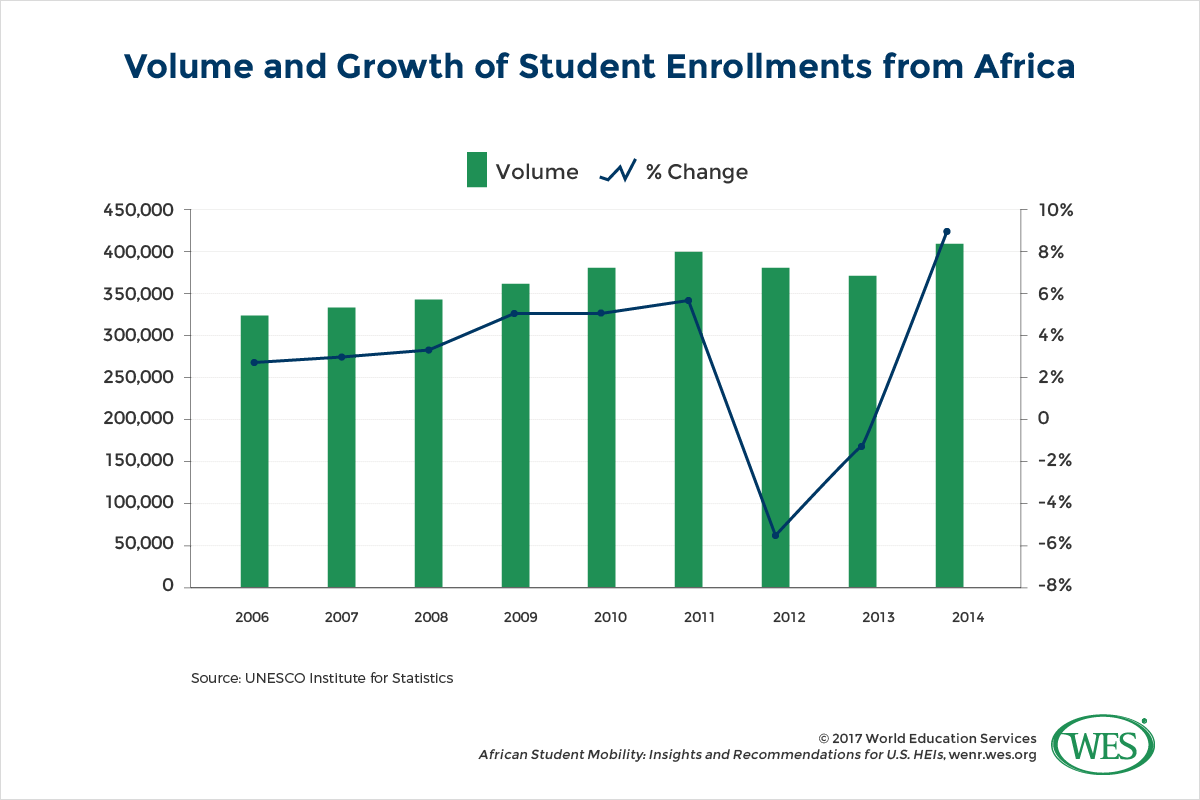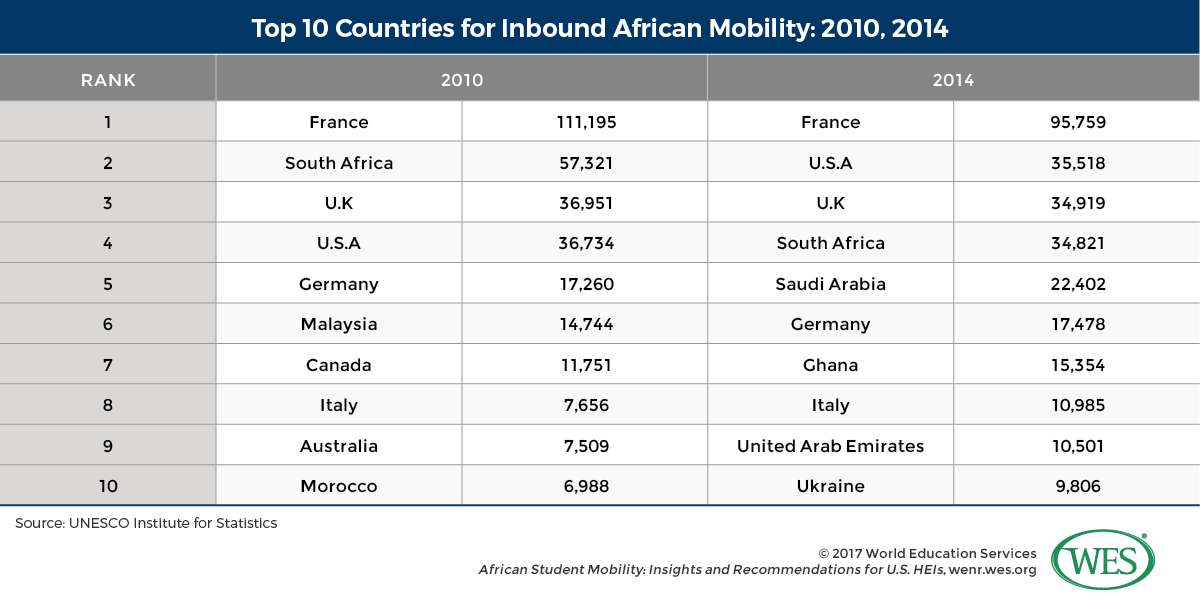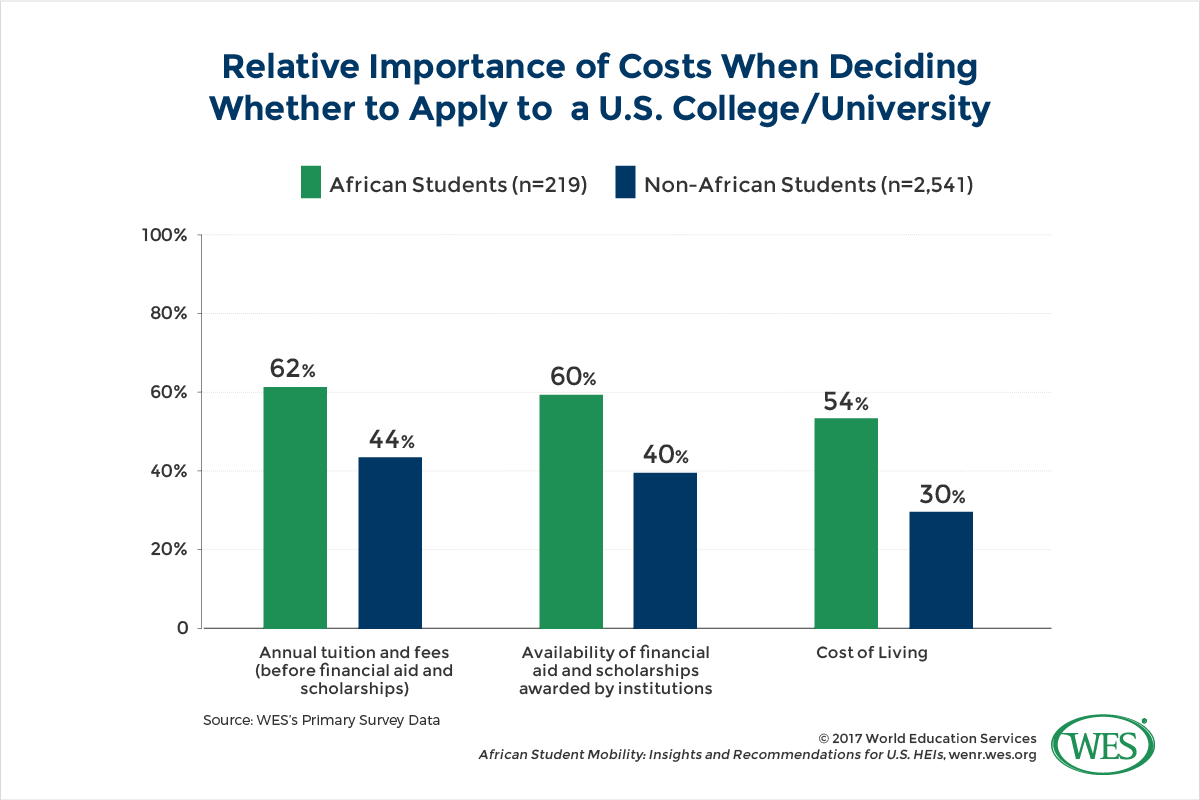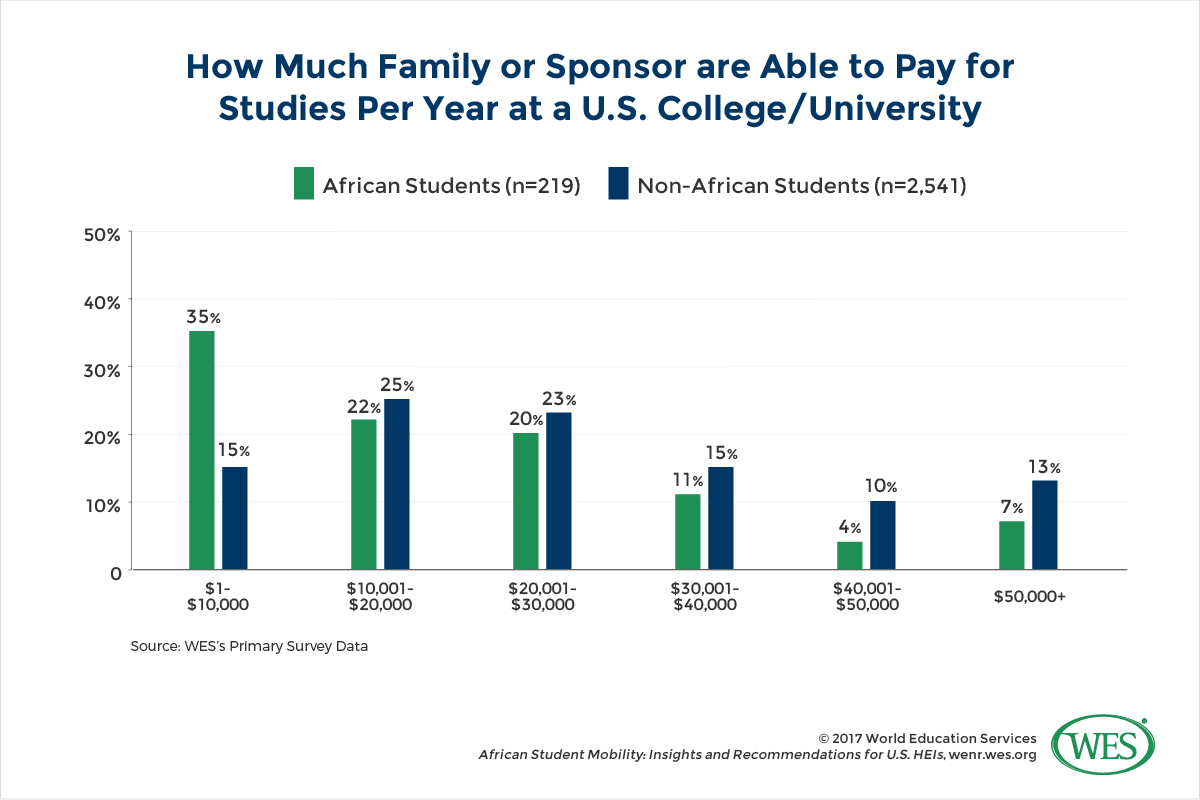Paul Schulmann, Senior Research Associate, WES
The African continent is the second largest and second most populous on earth, accounting for approximately one-fifth of the Earth’s land mass, and 15 percent of its population. As educational attainment levels have begun to creep up across the continent, so, too, have the numbers of qualified African youth seeking higher education abroad. Student outflow from the continent’s 54 nations in aggregate is considerable. As of 2013, African students comprised 10 percent [2] of all internationally mobile students around the world. From 2006 to 2014, the number of African students pursuing post-secondary degrees abroad grew 24 percent, rising from 343,370 to 427,311.http://uis.unesco.org/en/uis-student-flow [3], accessed February 2017. NOTE: Student mobility data from different sources such as UNESCO, the Institute for International Education, and the governments of various countries may be inconsistent. In some cases, organizations may report substantially different numbers of inbound or outbound international students from or in particular countries. This is due to a number of factors, including: data capture methodology, data integrity, definitions of ‘international student,’ and/or types of mobility captured (credit, degree, etc.). WENR’s policy is not to favor any given source over any other, but to try and be transparent about what we are reporting, and to footnote numbers which may raise questions about discrepancies. From 2013 to 2014 alone, it rose nine percent, reflecting a strong recovery after a two-year dip.largest source countries [4] for African international students. This decline may have occurred after a period of economic slowdown in Zimbabwe whose GDP growth shrank from 10.6 percent to 4.5 [5] percent from 2011 to 2012.
Which African Countries Have the Most Outbound Students?
The answer is simple at the broadest level: French- and English-speaking African nations account for about 99 percent [4] of all international students from Africa. Beyond that, the answer depends, to some degree, upon whom you ask. Counting students across borders is a surprisingly difficult exercise. It begins by defining the term “student.” Per UNESCO, a student, at least to be counted in reports on tertiary-level students’ global mobility, must not just travel to another country to study, but must be enrolled in a degree-granting foreign institution and pursuing a degree.[3]Another challenge with obtaining consistent numbers from different sources is verifiability of the data collected, especially when countries self-report. This definition puts a strict cap on the numbers, which are often in disagreement with those provided by institutions such as the U.S.-based Institute for International Education (IIE), which tracks U.S.-bound students, or IIE’s Project Atlas, which also tracks students who study for a brief period (e.g., a year, term, or summer) in an institution in another country for purposes of obtaining credits for their home institution. Nonetheless, the numbers reported by the UNESCO Institute of Statistics (UIS) provide some contextual understanding of which African countries generate the highest numbers of students studying abroad. According to the most recent UIS data available, the top ten senders are, in descending order:[4]UNESCO Institute for statistics, http://uis.unesco.org/en/uis-student-flow, accessed February 2017.
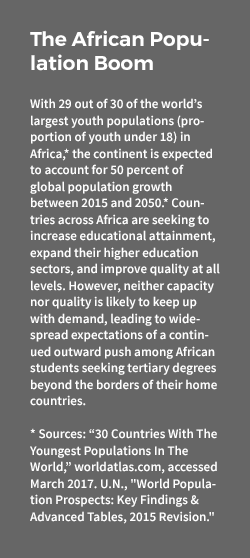 [6]Nigeria – UIS reports that Nigeria has some 1.4 million students enrolled at home, and that it has sent 71,351 degree-seeking students abroad. According to analysis from Campus France [2], a government agency tasked with promoting the country as an international education destination, Nigeria’s outbound student numbers grew by a staggering 45 percent from 2010 to 2013. These students’ top destinations are the U.K., Ghana, and the U.S., in no small part because Nigeria is home to a large English speaking population. Roughly one quarter of all U.S. enrolled African students are from Nigeria.[5]IIE, Open Doors 2016, accessed, February 2017.
[6]Nigeria – UIS reports that Nigeria has some 1.4 million students enrolled at home, and that it has sent 71,351 degree-seeking students abroad. According to analysis from Campus France [2], a government agency tasked with promoting the country as an international education destination, Nigeria’s outbound student numbers grew by a staggering 45 percent from 2010 to 2013. These students’ top destinations are the U.K., Ghana, and the U.S., in no small part because Nigeria is home to a large English speaking population. Roughly one quarter of all U.S. enrolled African students are from Nigeria.[5]IIE, Open Doors 2016, accessed, February 2017.
- Morocco was long a top African country of origin for international students, but, as ICEF Monitor [4] noted in 2016, “somewhere between 2010 and 2012 Nigerian outbound mobility surpasse[d] that of Morocco [8].” Recent UIS reports showed some 43,148 Moroccan students enrolled abroad. More than 25,000 went to France.[6]IIE’s Project Atlas, which gather numbers differently than UIS, reports that 36,768 Moroccon students were enrolled in French institutions in 2015/16. Another 5,700 went to Spain and Germany.[7]When looking at outbound mobility from the African continent as a whole, growth in outbound mobility from Nigeria has helped to offset tepid growth and in some instances declines from Francophone countries – Morocco, Algeria, Cameroon, and Zimbabwe – that have typically been major countries of origin for outbound African students.
- Cameroon sent 23,131 degree-seeking students (out of 245,000 total enrolled students) abroad per UIS data. Of these students, 69 percent (15,474) sought out European institutions in Germany, France, Italy, and Belgium. Some 5.5 percent (1,268) sought degrees in the U.S.
- Algeria sent 20,493 students abroad; almost 81 percent of those students (16,558) sought out degrees in France, the colonial power from which it gained independence in 1962.
- Zimbabwe sent 16,563 degree-seeking students abroad. More than 10,000 of those went to South Africa. The U.S., with 1,268 students, was Zimbabweans second leading destination.
- Kenya sent 13,024 degree-seeking students abroad. U.S. institutions enrolled 3,177 of these students, making the United States Kenyan students’ leading destination. Other top countries include the U.K., Australia, and South Africa.
- Senegal sent 11,410 abroad, with 7,439 headed to France. The U.S., with under 700 students, was Senegalese degree seekers’ second leading destination.
- Angola sent some 11,121 students abroad. Top three destinations include Brazil, Portugal, and the U.S. African nations, including Gambia and South Africa, take up slots four and five.
- Ghana sends 11,116 students abroad. The U.S. is a top destination country, attracting more than 3,142 students.
- Sudan rounds out the top 10, reportedly sending some 10,058 degree-seeking students abroad. Beyond that raw number, UIS has no other data available.
Higher Education Destinations for African Students: A Move Away From France, The U.K., and South Africa
A quick glance at the list of top 10 destinations for African degree seekers in 2010 versus 2014 shows interesting developments. France is in the top slot both years, although numbers fell from 111,195 to 95,759 – a dramatic 14 percent. Among the top four nations in the same period, U.S. enrollments remained largely stable, while the U.K. and South Africa dropped, the former marginally, and the latter by a staggering 39 percent, from just over 57,000 to just under 35,000. Locations such as Saudi Arabia, Ghana, the United Arab Emirates, and Ukraine, meanwhile, all broke into the top-ten list for African students in the same period. (See figure 2). These breakthroughs often involved substantial numbers of students: Saudi Arabia emerged as the number five destination in 2014, with 22,402 African enrollments (up from fewer than 7,000 in 2010.) Ghana appears on the 2014 top 10 destination list at number seven, with 15,354 students.
The shifting patterns reflect demographics within African nations themselves as well as conscious efforts by governments and institutions in new destinations to recruit international students. For instance:
- Middle Eastern countries [10] have, in recent years, begun to offer scholarships [11] to attract international students, a powerful lure [12] for students from Africa who often have few financial resources to dedicate to their studies. For African students from Arab countries such as Morocco, Libya, Tunisia, Algeria, and Egypt, the incentives [13] to study in Saudi Arabia are even more pronounced, as Arab students often receive fully furnished accommodations. The most recent numbers tracked by the UNESCO Institute for Statistics [3] indicate that Egypt was the third leading county of origin for students to Saudi Arabia, sending some 4,560 out of 73,077. [Related content: Academic Mobility in the Middle East and Egypt: If not West, Where Will Students Go? [10]]
- China has made a concerted effort to attract post-secondary African students, both for degree programs and for vocational and shorter term programs. In 2016, China’s Ministry of Education reported that African students accounted for 12.5 percent of the country’s total foreign student population of the nation’s 397,635 foreign students [14].[8]The majority of foreign students in China in 2015 were enrolled in non-degree courses, mainly in language and cultural programs. Only a third of the total are enrolled in university degree courses. [See related article in this issue:The Sino-African Higher Educational Exchange: How Big Is It and Will It Continue? [15]]
- Ghana is, according to official estimates, the third leading destination country for globally mobile students in Africa, behind Senegal and South Africa. It attracts significant student numbers from Nigeria, in particular. The quality of higher education in Ghana, however, is questionable, despite ongoing efforts [16] to bolster it. Rapid expansion over a short period, especially in the private sector, has occurred at the expense of quality control [17]. As Times Higher Education [18] reported in 2013, “according to Ivan Addae-Mensah, who was vice-chancellor of the University of Ghana [19] from 1996 to 2002, there were just 9,000 students in Ghana’s three public universities in 1987. But by 2010… the country had six public universities with 115,346 students. Burgeoning enrolments in newly created polytechnics, colleges of higher education and other specialist institutions, meanwhile, sent total tertiary enrolments soaring above 200,000.”
What Is the Potential for Attracting Additional African Students to the U.S.?
The U.S., of course, has no coordinated approach [21] to attract international students. And while the country looms large as a destination for Africa’s outbound students (it was number two on the list of top ten countries for outbound African students in 2014), they remain a relative rarity amid a sea of students from Asia. According to the U.S.-based Institute for International Education only four percent of foreign students in the U.S. for the 2015/16 academic year [22] were African (some 40,285 students).[9]UIS reports data differently than IIE’s Open Doors report; however an analysis of UIS data shows similarly small numbers of African students in the U.S.: Together, the 25 African countries whose students select U.S. schools as their number one, two, or three choice of enrollment destination is just over 30,000. By contrast, Asian students account for more than 66 percent of international student roles.
Despite their small numbers, African students can bring an invaluable perspective and drive to campuses, say university leaders who have worked with recent cohorts of students from Africa. The University of Rochester in New York has become a top host of graduates of the African Leadership Academy [23], a college preparatory program that seeks out students across Africa and helps to place them in institutions around the world. University Vice Provost and Dean of Admissions Jonathan Burdick notes that these students, most of them engineers working to address very concrete challenges, have an outsize impact in their departments and on campus.
Across the U.S., African students represent, at best, a small fraction of the international student mix on campuses. Cost is a chief reason. Although the economies throughout the continent differ dramatically in terms of development, the region as a whole is the least economically developed in the world. The U.S., meanwhile, has both a strong economy and strong dollar. It is also among the most expensive [24] places in the world to study, particularly for international students who pay out-of-state tuition at public colleges and universities. Research bears out the assumption that cost is a chief barrier to entry for many African students who might otherwise enroll U.S. schools. For instance:
- Survey data collected for a 2015 WES report, How Master’s Students Choose Institutions: Research on International Student Segmentation, [12] indicates that prospective international students from Africa were much more likely than other respondents to cite cost as the most important attribute in determining which programs to attend: some 30 percent of sub-Saharan respondents cited cost as a deciding factor for enrolling, compared to approximately 15 percent on average.
- A review of aggregate data from survey responses by North African and sub-Saharan students at all education levels shows similarly high levels of price-sensitivity, with 29 percent indicating that cost was their primary concern.[10]The original WES report, How Master’s Students Choose Institutions: Research on International Student Segmentation, combined North African and Middle Eastern Students into one region “MENA” and other African students into sub-Saharan Africa.
- Of the top two challenges that African respondents identified, “cost of living expenses” and “cost of tuition fees” were each named by 71 percent of African students. (The third most common challenge, “loneliness/ homesickness” paled in comparison at 35 percent.)
- Thirty-five percent of African survey respondents indicated that they have $10,000 per year or less to use towards their education, more than twice the proportion of students from elsewhere (see figure 4).
WES research data also provides insight into the problematic aspects of cost at a more granular level. What we’ve learned is that students from Africa are far more likely than students from elsewhere to indicate that the annual tuition, availability of financial aid and scholarships, and the cost of living are “very important” in determining where to apply.
Recommendations for U.S. HEIs Seeking to Increase African Students’ Enrollments
Focus on the long game: Analysis of World Bank and CIA World Factbook data positions six African nations in the top 13 list [27] of fastest growing economies in terms of gross domestic product. Often, economic development outpaces quality and capacity [28] improvements in higher education, and Africa’s relatively underdeveloped economies can hide the fact that the continent is brimming with potential. Not only is the continent home to three of the top 10 [29] fastest growing economies, but it is also home to 29 out of 30 countries with the largest proportion of the population under 18 years old [30]. The continent’s burgeoning economies require a well-trained and educated work force. Given the continent’s growing youth population, this economic growth, stutter-stop though it may be, represents an excellent opportunity [31] for HEIs interested in diversifying international enrollments. With African student destinations now in flux, it behooves HEIs seeking to diversify their enrollments beyond the two mainstays of China and India, to look to countries like Nigeria and other top African countries of origin for international students to identify and recruit capable, driven students.
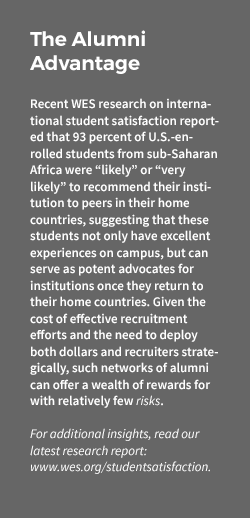 [32]Emphasize quality and specific programs of study: Analysis of data gathered for a 2016 WES report, Improving the International Student Experience: Implications for Recruitment and Support [33], finds that “better education outside of my home country” is the top reason 70 percent of African respondents leave their country of origin to enroll in institutions abroad.top 500 universities [34] in the world are in Africa, both in South Africa. While rankings are far from reliable, the finding is nonetheless an indicator of a more pervasive lack of quality [35] at many institutions, especially the private schools that have emerged to absorb growing demand throughout the continent.
[32]Emphasize quality and specific programs of study: Analysis of data gathered for a 2016 WES report, Improving the International Student Experience: Implications for Recruitment and Support [33], finds that “better education outside of my home country” is the top reason 70 percent of African respondents leave their country of origin to enroll in institutions abroad.top 500 universities [34] in the world are in Africa, both in South Africa. While rankings are far from reliable, the finding is nonetheless an indicator of a more pervasive lack of quality [35] at many institutions, especially the private schools that have emerged to absorb growing demand throughout the continent.
In terms of why respondents enrolled in U.S. institutions, one reason identified by 62 percent of survey respondents was “availability of a desired program,” – a top three motivator. Data on African students’ choice of majors is somewhat scarce. However, we know that, among Nigerians, the largest contingent of African students in the U.S., the most popular field of study [36] is engineering (22 percent) followed by business (15 percent), and health professions (13 percent). (Notably, out of the top 25 source countries for international students, Nigeria follows only Canada in terms of enrollment in the health professions.) This suggests that institutions with strong programs in these fields should consider Africa as a promising source for international students, and emphasize either affordability or aid to attract qualified candidates.
Offer financial support, or promote affordability: Cost is a difficult factor for many U.S. HEIs to address; however schools with competitive tuition fees or scholarships for international students are well positioned to attract African students. In fact, in our recent survey, 38 percent of African students suggested that the availability of financial aid/ scholarships was why they enrolled in a U.S. institution. The data also suggest significant opportunities for community colleges [37], which can help international students by lowering the burden of cost through transfer programs. (At present, only one African nation factors into the top 25 countries [38] list at the community college level, Nigeria, which is the 17th largest country of origin.)
References
| http://uis.unesco.org/en/uis-student-flow [3], accessed February 2017. NOTE: Student mobility data from different sources such as UNESCO, the Institute for International Education, and the governments of various countries may be inconsistent. In some cases, organizations may report substantially different numbers of inbound or outbound international students from or in particular countries. This is due to a number of factors, including: data capture methodology, data integrity, definitions of ‘international student,’ and/or types of mobility captured (credit, degree, etc.). WENR’s policy is not to favor any given source over any other, but to try and be transparent about what we are reporting, and to footnote numbers which may raise questions about discrepancies. | |
|---|---|
| largest source countries [4] for African international students. This decline may have occurred after a period of economic slowdown in Zimbabwe whose GDP growth shrank from 10.6 percent to 4.5 [5] percent from 2011 to 2012. | |
| ↑3 | Another challenge with obtaining consistent numbers from different sources is verifiability of the data collected, especially when countries self-report. |
| ↑4 | UNESCO Institute for statistics, http://uis.unesco.org/en/uis-student-flow, accessed February 2017. |
| ↑5 | IIE, Open Doors 2016, accessed, February 2017. |
| ↑6 | IIE’s Project Atlas, which gather numbers differently than UIS, reports that 36,768 Moroccon students were enrolled in French institutions in 2015/16. |
| ↑7 | When looking at outbound mobility from the African continent as a whole, growth in outbound mobility from Nigeria has helped to offset tepid growth and in some instances declines from Francophone countries – Morocco, Algeria, Cameroon, and Zimbabwe – that have typically been major countries of origin for outbound African students. |
| ↑8 | The majority of foreign students in China in 2015 were enrolled in non-degree courses, mainly in language and cultural programs. Only a third of the total are enrolled in university degree courses. |
| ↑9 | UIS reports data differently than IIE’s Open Doors report; however an analysis of UIS data shows similarly small numbers of African students in the U.S.: Together, the 25 African countries whose students select U.S. schools as their number one, two, or three choice of enrollment destination is just over 30,000. |
| ↑10 | The original WES report, How Master’s Students Choose Institutions: Research on International Student Segmentation, combined North African and Middle Eastern Students into one region “MENA” and other African students into sub-Saharan Africa. |
| ↑11 | The original WES report, Improving the International Student Experience: Implications for Recruitment and Support, combined North African and Middle Eastern Students into one region “MENA” and other African students into sub-Saharan Africa. |

